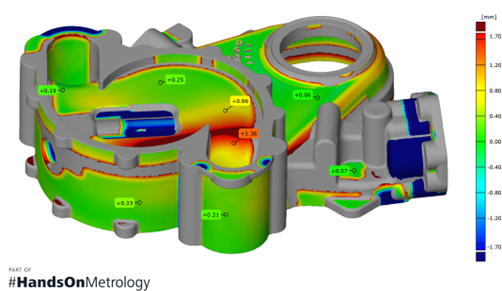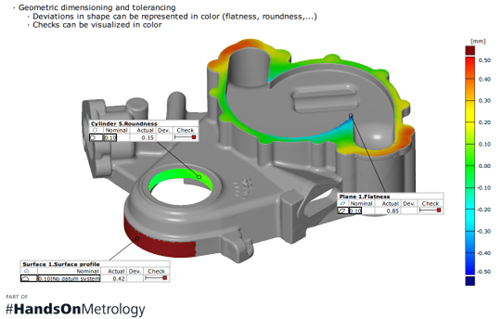Workpieces manufactured from casting processes play an essential role in the industry due to their versatility. In this article, MEGA Tech would like to present the application of three-dimensional scanner in quality enhancement of cast pieces, which impacts the productivity and raises the quality level of factories.
3D Scanner is a machine utilized in surface of non-contact workpieces measurement. The process is conducted by measuring the coordinate points on the material surface referred to as Cloud Point, which is subsequently converted into either micro texture or mesh surface. The mesh surface facilitates connection with the surface of the entire workpiece, enabling utilization in engineering applications. The 3D scanner can be used on cast pieces as followings:
1. Minimization of Errors in Production
The mold casting process encompasses various workpieces, which may be influenced by the size of the pattern. Discrepancies in sizes may result in production of incorrectly sized workpieces, necessitating corrective measures beforehand. ZEISS Inspect Pro enables initial measurements of several workpieces beforehand, such as sand mold and core parts, to ensure the correct shape, identify size discrepancies, and detect any support areas. Precision and speed will be enhanced when these components are assembled.
An assessment of material allowance is carried out (Allowance Check) involving the machining process, ensuring an optimum balance, where inadequacy could result in imperfections, such as cracks and air pockets, and excessiveness in contrast leads to time consumption and increase in production costs.
Mold wear inspection and location identification on the workpiece is facilitated by utilizing a 3D scanner to compare the measurements with the data in CAD. This enables identification of areas causing deterioration and incorrect dimensions from the determined reference point, allowing prompt and precise adjustments to be made.
2. Product Design and Development
The 3D scanner allows measurement of prototype workpiece with high accuracy and speed, enabling the product designer and developer to operate swiftly while still maintaining the work quality. In addition, ZEISS Inspect Pro can now function in a Scan to CAD manner directly without using additional software, facilitating measurement and reverse engineering for enhanced ease and convenience.


3. Quality Inspection
Enhances the accuracy of inspection to build production credibility in terms of general size inspection or inspection works as the followings:
- Comparison of workpieces measured with CAD (deviation to CAD) by showing color gradients indicating deviations from the prototype.
- Employed in thickness verification, as reports of measurements focus exclusively on thickness parameters. As can be seen in the illustrated image, the dark blue area has a wall thickness below the standard threshold of – 1.7 mm, making the abnormality visible.
- GD & T inspection: ZEISS Inspect Pro can report the results in accordance with the GD & T standards in all aspects, including in numerical forms and color variations. For instance, the report can indicate the values of cylindrical, roundness, profile of surface, and flatness.
The crucial technology of 3D scanner in the industry, which requires high accuracy, endurance, and versatility, is available in 2 forms:
- 3D laser scanner utilizes laser beams to project onto the workpiece, capturing reflections to generate Cloud Point, which are then converted into Mesh. Presently, it has gained popularity due to its compact size, portability, and ease in mobility. ZEISS has developed a portable HandsOnMetrology 3D scanner in the T-Scan Hawk 2 model, which has unique features as the followings:
- Compact size, lightweight, ease in mobility, enabling utilization in any operating areas
- Swift and accurate scanning, allowing utilization of multiple blue laser crosses to adjust resolution while scanning within a single task, facilitating quick and precise measurements of both general and intricate works.
- Workflow Assistance facilitates convenience and can be controlled directly by the handle, where controlling through a computer will not be necessary.
- Measurement of large workpieces with Satellite Mode, scanning areas up to 4 meters without requiring photogrammetry and marker, as well as maintaining the accuracy to up to 0.02 mm + 0.015 mm/m.
- Dark and Shiny Surfaces mode is employed especially for black and glossy surfaces, making it possible to work with a diverse array of surfaces and materials.

2. Blue light 3D scanner emits blue light through fringe projections of varying sizes onto the workpiece at a rapid pace using a high-resolution camera positioned on the left and right sides of the machine capture images, which are then used as Cloud Point to be converted into Mesh.

From the provided information, it is evident that 3D scanner possesses versatility in their applications within the casting process. In addition, it is beneficial in several productions, including product design, mold production, analysis, parts repairment, and inspection of workpieces prior to milling and assembly.
Article by: MEGA Tech & Factory Max (Thailand) Co., Ltd. << Click Here

